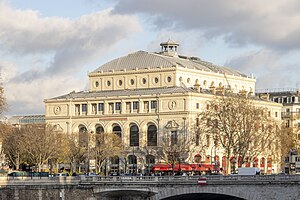Théâtre de la Ville
 Façade on the Place du Châtelet | |
 | |
| Former names |
|
|---|---|
| Address | 2 Place du Châtelet, 4th arrondissement Paris |
| Coordinates | 48°51′26″N 02°20′53″E / 48.85722°N 2.34806°E |
| Capacity | 1,750 (1868)[1] 1,600 (1874)[2] |
| Construction | |
| Opened | 30 October 1862 21 May 1871 (destroyed by fire) 6 November 1874 (reopened)[2] |
| Architect | Gabriel Davioud |
| Website | |
| www.theatredelaville-paris.com | |
The Théâtre de la Ville (meaning the City Theatre) is one of the two
Included among its many previous names are Théâtre Lyrique, Théâtre des Nations, and Théâtre Sarah-Bernhardt.
Théâtre Lyrique
The theatre, which until the fall of
Théâtre Historique and Théâtre des Nations
The theatre was rebuilt in 1874 on the same plans and was at first called the Théâtre Lyrique-Dramatique,
Opéra-Comique
In 1887 the Opéra-Comique moved into the theatre after its previous home, the second Salle Favart, had been destroyed by fire. The name Théâtre Lyrique was restored, and the Opéra-Comique continued to perform in the theatre until 1898, when it returned to the newly built, third Salle Favart. During the company's sojourn on the Place du Châtelet, it presented several operas by Massenet, including the premieres of Esclarmonde (1889) and Sapho (1897), as well as the first Paris performances of Werther (6 January 1893) and La Navarraise (3 October 1895).[6][13]
Théâtre Sarah-Bernhardt

In 1899 the theatre was renamed Théâtre Sarah-Bernhardt after the renowned actress
The theatre kept the name Sarah Bernhardt until the
Diaghilev's
Théâtre des Nations
The theatre was once again renamed as the Théâtre des Nations in 1957.[8]
Théâtre de la Ville
The theatre first acquired the name Théâtre de la Ville in 1968.
References
Notes
- ^ Galignani's New Paris Guide for 1868, p. 470.
- ^ a b c d Almanach des Spectacles, année 1874 p. 87 Archived 29 May 2021 at the Wayback Machine.
- ^ a b c Walsh 1981, pp. 149–239, 316–321.
- ^ Almanach des Spectacles, année 1876 p. 75 Archived 28 May 2021 at the Wayback Machine.
- ^ a b Lecomte 1905, p. 38 Archived 29 May 2021 at the Wayback Machine (Théâtre Lyrique-Dramatique), p. 32 Archived 28 May 2021 at the Wayback Machine (Théâtre Historique), p. 43 Archived 29 May 2021 at the Wayback Machine (Théâtre des Nations).
- ^ a b c d e f Simeone 2000, p. 203.
- ^ a b c McCormick 1995.
- ^ a b c d e f Based on the corresponding article in the French Wikipédia (version 12 juin 2012 à 11:13).
- ^ Walsh 1981, pp. 149–150.
- ^ Walsh 1981, pp. 241–267, 321–322.
- ^ Walsh 1981, pp. 274–275.
- ^ Irvine 1994, p. 139.
- ^ Wild & Charlton 2003, pp. 97, 339.
- Gallica.
Sources
- Banham, Martin (1995). The Cambridge Guide to the Theatre. Cambridge: Cambridge University Press. ISBN 9780521434379.
- Irvine, Demar (1994). Massenet: A Chronicle of His Life and Times. Portland, Oregon: Amadeus Press. ISBN 9780931340635.
- Lecomte, Louis-Henry (1905). Histoire des théâtres 1402–1904. Notice préliminaire. Paris: Daragon. View at Google Books.
- McCormick, John (1995). "Bernhardt, Sarah" in Banham 1995, pp. 98–99.
- Simeone, Nigel (2000). Paris – A Musical Gazetteer. New Haven: Yale University Press. ISBN 978-0-300-08053-7.
- ISBN 978-0-7145-3659-0.
- Wild, Nicole; Charlton, David (2005). Théâtre de l'Opéra-Comique Paris: répertoire 1762-1972. Sprimont, Belgium: Editions Mardaga. ISBN 978-2-87009-898-1.
